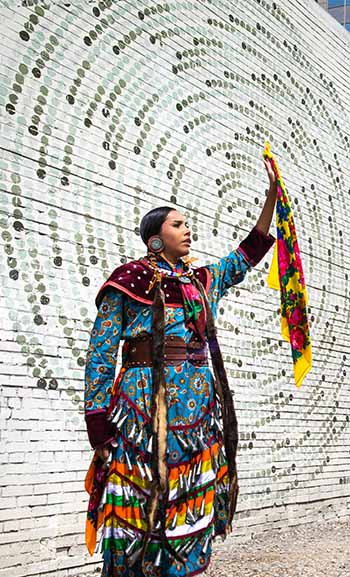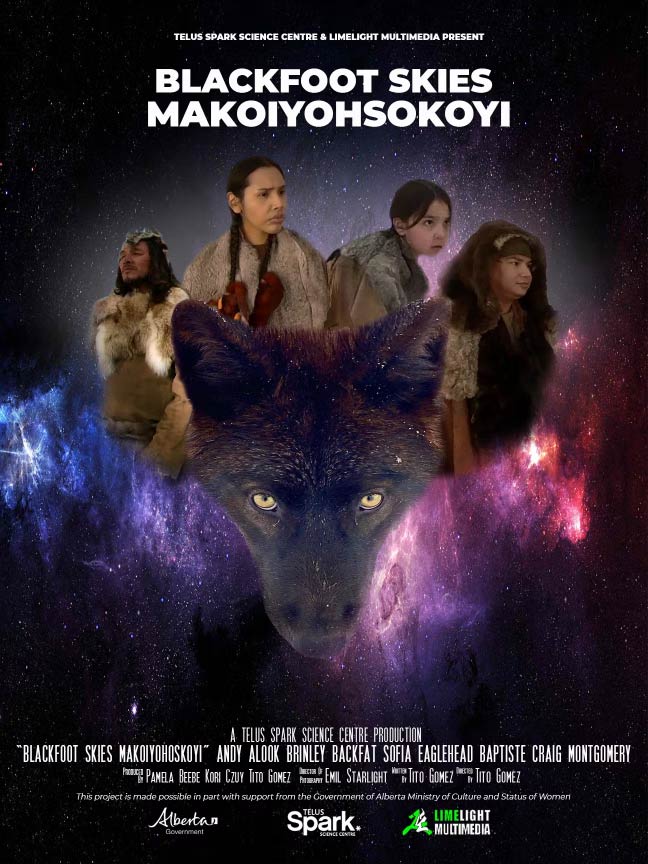Dancing to connect, learn and heal
Anthropology student Sofia Baptiste explores her Indigenous roots
Mount Royal student, Sofia Eaglehead Baptiste, came to MRU looking for a post-secondary education, but through powwow dances and learning Indigenous ways of knowing she also embarked on a journey of self-discovery and connecting with her Indigenous ancestry.
Baptiste is Blackfoot, Tsuut’ina and Cree and calls both Mohkinstsis (Calgary) and Pigeon Lake home. Currently in her final year of study at Mount Royal, she is a Bachelor of Arts — Anthropology major with a double minor in Indigenous Studies and Sociology.
In addition to being a student, Baptiste is also a model, actor and traditional powwow dancer.
While she had always wanted to learn to dance while growing up, the opportunity to learn didn’t present itself until 2018. Inspired by a powwow she had recently attended and with encouragement from her best friend, Baptiste bought material, created a dress and began taking Powwow Fit classes at Mount Royal through the Iniskim Centre.
“When we dance, we pray and we think about whatever we want to focus on. This can be our community, loved ones, people who have gone on or people who are struggling.” -Sofia Baptiste
Taught by Nikita Kahpeaysewat, a friend of Baptiste and fellow MRU student, Powwow Fit classes cover traditional dance steps and concepts of Indigenous dance styles. Participants learn about the cultural meanings of what powwow is, how it contributes to Indigenous practices in today’s society and the historical representations of each dance style.
“When I started school that fall, I went to almost every Powwow Fit class and we danced all different styles,” Baptiste explains.
Originally thinking she wanted to dance fancy, which includes bright colours, jumping and spinning, Baptiste instead found herself drawn to the jingle dress dance. “I remember when Nikita was teaching us jingle and she danced old style, she just looked so elegant and so beautiful. I was like, ‘that’s the style I want to dance.’”
Originating from the Ojibwe Nation, the jingle dress dance is steeped in tradition and history. It includes dresses with rows of decorative metal cones and light footwork danced close to ground. While Baptiste says she still has more to learn before she can speak to the story behind the dance, she shares that it is strongly connected to healing.
“When we dance, we pray and we think about whatever we want to focus on. This can be our community, loved ones, people who have gone on or people who are struggling. We can also pray for ourselves,” she says. “A lot of the times when I dance, I pray for the residential school survivors because my parents are residential school survivors.”
While dancing has helped Baptiste connect with her culture and begin healing, she shares that she continues to live with intergenerational trauma every day. “I was anxious because I didn’t want to make mistakes. I didn’t even think I was smart,” she says of how it affected her educational pursuits.
“As Indigenous people we are aware that we walk in two worlds. Our own worldview and the western world that is a result of contact...It is important to learn the stories and traditions of the land.”-Sofia Baptiste

Despite facing barriers, Baptiste has found her academic stride at Mount Royal, which she attributes to the support of her family and Indigenous community. “I gained a lot of confidence in who I am as a person through the Iniskim Centre and through the great connections I made with different professors.”
One of the professors who made a lasting impact on Baptiste was Dr. Gabrielle Lindstrom, PhD. “I remember the moment I saw her. I didn’t expect to see a Blackfoot woman come into the class and I was really inspired by her,” Baptiste says, adding this was the first time she had ever had an Indigenous instructor. “She’s an amazing professor and so knowledgeable and kind and everything that I think a Blackfoot person embodies.”
Baptiste says having Blackfoot ways of knowing being a part of her education has also helped her to connect with the community and learn more about herself, including the perspective of walking in two worlds.
“As Indigenous people we are aware that we walk in two worlds. Our own worldview and the western world that is a result of contact,” she explains. “However, everyone who has settled within Turtle island (the America’s) also walk in two worlds. They tend to only know from the perspective of the western worldview and clumsily walk through the Indigenous worldview… It is important to learn the stories and traditions of the land.”
“(Blackfoot Skies Makoiyohsokoyi) is something I feel so blessed to be a part of. It is an all Indigenous cast and crew, and shares a Blackfoot story. I love being Blackfoot and I am honoured that I was cast in this short film.”
 Sharing one of these stories with the public is the catalyst behind Blackfoot Skies Makoiyohsokoyi, a soon-to-launch short film Baptiste was cast in in collaboration with Telus SPARK Science Centre. Written and directed by Tito Gomez, the film is based on an original Siksikaitsitapi story gifted to the science centre by the late Dan Weasel Moccasin in the early 1990’s.
Sharing one of these stories with the public is the catalyst behind Blackfoot Skies Makoiyohsokoyi, a soon-to-launch short film Baptiste was cast in in collaboration with Telus SPARK Science Centre. Written and directed by Tito Gomez, the film is based on an original Siksikaitsitapi story gifted to the science centre by the late Dan Weasel Moccasin in the early 1990’s.
“This project is something I feel so blessed to be a part of. It is an all Indigenous cast and crew, and shares a Blackfoot story. I love being Blackfoot and I am honoured that I was cast in this short film,” Baptiste says.
Whether through dancing, sharing stories or pursuing education, Baptiste continues to learn, heal and carry on traditions. Her story stands as an inspiring reminder of the power of perseverance and supporting others to find their full potential.

